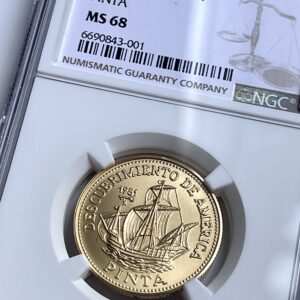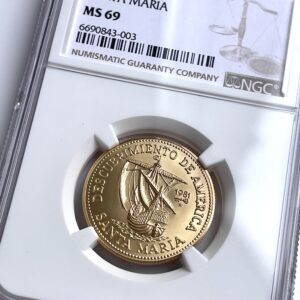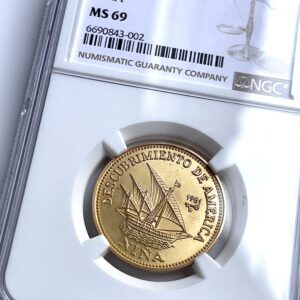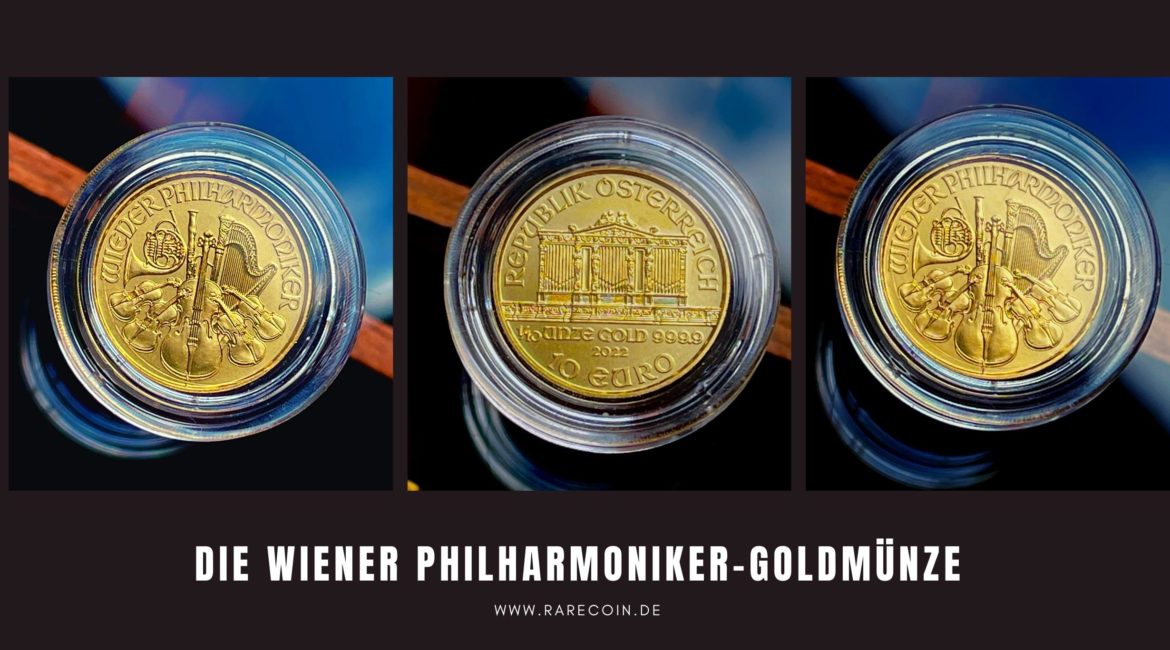The bullion coin
On October 10, 1989, one of Europe’s most popular bullion coins, the Vienna Philharmonic, was introduced. Together with Krugerrand, Maple Leaf, American Eagle, Australian Kangaroo, Sovereign, Britannia and China Panda, the Vienna Philarmonic is one of the best known gold coins outside Europe. The coin is dedicated to the Vienna Symphony Orchestra (founded on March 28, 1824 by German composer and conductor Otto Nicolai), known worldwide for its world-class musical performances.
Austria was the second country after Great Britain to mint an official gold coin. Originally, before the introduction of the euro in 2002, the Philharmoniker was denominated in Austrian schillings. Thus, a coin weighing one troy ounce (31.1 grams) was equivalent to 2000 shillings (100 euros today) and a coin weighing ½ ounce was equivalent to 1000 shillings (50 euros).
It is worth noting that until 1991 the Philharmonic was minted in two weight classes – 1 ounce and ¼ ounce. However, after its highly successful appearance on the precious metals market, the 1/10 ounce was introduced in 1991 and the ½ ounce Philharmonic in 1994, followed by the 1/25 ounce in gold in 2014.
The Vienna Philharmonic is not only the most important coin of Austria, but it is also one of the few bullion coins with a face value in euros. The Philharmonic was first issued in 1989 and has since gained popularity not only among the citizens of the European Union, but also around the world.
History of the Vienna Philharmonic Gold Coin
Since the Philharmonic originated in Austria, the coin was minted by the Austrian Mint at the end of the last century. Originally, these coins were minted in two formats, depending on the weight of the piece – a troy ounce and a quarter ounce. The resulting mintages were sold successfully, so in 1991 new versions were created: a 1/10 ounce and a ½ ounce.
Interesting is the fact that the design and layout of the coin have not undergone any changes. According to the statistics of the World Gold Council, the Vienna Philharmonic has been one of the best-selling coins for several years in a row. It has a large diameter for such coins (37 mm) and at the same time is quite thin (about 2 mm), which makes it very difficult to counterfeit the Philharmonic.
Austria Mint
Year founded: 1397 Location: Austria, Vienna
The date of foundation of the Austrian Mint is 1397. The oldest coin in Austria is the Guldiner, issued in 1484 during the reign of Archduke Sigismund. After the accession of the Roman Emperor Ferdinand I to power, a new currency was introduced in Austria – the thalers, which were in circulation in Rome at that time. The silver thaler was recognized as the basic currency of Austria and was later called the Reichsthaler.
The new monetary unit remained in use until 1753, when it was replaced by the issuance of a new talers, the convention talers. The convention thaler (also known as convention thaler), spelling until 1901 …thaler, was the thaler coin of many minting states of the Holy Roman Empire after the 20-guilder foot of the 1753 Minting Convention.
The Austrian Mint is located in one of the most prestigious districts of Vienna. The majestic building is adjacent to some of the most famous centers for classical music, the Vienna Konzerthaus and the Musikverein, the latter being the alma mater of the Vienna Philharmonic Orchestra. The Austrian Mint – in terms of appearance – can be called a temple. Despite its antique appearance, the magnificent classical facade hides a modern mint factory. Here, centuries-old craftsmanship and tradition are combined with world-leading minting technology, which in most cases was developed and introduced by experts from the Austrian Mint itself.
In 1857, Austria and Germany decided to issue a common currency – the Allied Thaler. This currency existed until 1892, when a new monetary unit – the crown – was introduced.
Over the years, the Austrian Mint has changed its currency more than once. Until 2002, coins with the denomination Austrian Schilling were minted there. The Austrian Mint has been minting euro coins since 2002. The mint produces not only coins, but also medals.
Face value and main features of the Vienna Philharmonic coin
The Vienna Philharmonic is minted at the Austrian Mint. The highest gold standards are used and the purity of the metal and the quality are guaranteed by the Austrian National Bank. The coin is made of 0.9999 proof (24 carat gold). The price of these coins fluctuates daily depending on the daily gold prices on the exchanges in New York and London. Modern philharmonics have the following denominations:
- 100 Euro
- 50 euro
- 25 Euro
- 10 euros.
Initially, the coins were available only in gold, from 2008 in silver and from 2016 in platinum. The coins are available in 5 weight classes:
- 1 oz,
- 1/2 oz,
- 1/4 oz,
- 1/10 oz,
- 1/25 oz.
The most popular 1-ounce coin is equal to 31.1 grams. Its original face value was 2000 shillings, from 2002 the coin was changed to 100 euros.
The Golden Philharmonic – Technical data
ATS (ATS = Austrian Shilling -> Österreichischer Schilling) issued until 2002, before the introduction of the euro.
Gold with a purity grade of 999.9.
Denomination 100 €/2000 ATS
Size: 1 ounce
Weight: 31,103 g
Diameter: 37.0 mm
Thickness: 2.0 mm
Available since: since 1989
Denomination: 50 €/1000 ATS
Size: 1/2 ounce
Weight: 15,552 g
Diameter: 28.0 mm
Thickness: 1.6 mm
Available since: 1994
Denomination: 25 €/500 ATS
Size: 1/4 ounce
Weight: 7,776 g
Diameter: 22.0 mm
Thickness: 1.2 mm
Available since: 1989
Denomination: 10 €/200 ATS
Size: 1/10 ounce
Weight: 3,121
Diameter: 16.0 mm
Thickness: 1.1 mm
Available since: 1991
Denomination: 10 €
Size: 1/25 ounce
Weight: 1.2441 g
Diameter: 13.0 mm
Thickness: 0.8 mm
Available since: 2014
Design
The obverse (also known as the obverse ) of the coin depicts the instruments of the Vienna Orchestra: the cello in the center, flanked on the right and left by two violins and two violas, with bassoon, horn and harp in the background and the text Vienna Philharmonic.
Thereverse side (also known as the lapel ) depicts the organ in the Golden Hall of the Musikverein, where the traditional New Year’s Eve concert has been held since 1939. The Musikverein is the main venue of the Vienna Philharmonic Orchestra. You will also find the inscription “REPUBLIK OSTERREICH” and information about the coin: Size, metal, denomination, proof and year of issue.
Big Phil – VIENNA PHILHARMONICS – 1.000 UNZEN GOLD
In 2004, the Austrian Mint issued a 31.103 kg gold coin called “Big Phil”. The occasion was the 15th anniversary of the first coin of the Vienna Philharmonic Orchestra, which was a great success. The nominal value of the Big Phil is 100 000 euros with a diameter of 37 centimeters and a thickness of 2 centimeters. A total of 15 Big Phils were issued – corresponding to the number of years since the Vienna Philharmonic brand was created. 14 coins are in private collections, 1 coin is kept in the National Bank Museum in Vienna.
Trust and standards
When it comes to bullion coins, customers trust the Mint’s products based on a few key criteria: excellent quality, gold content, fair price and brand recognition. This means that the Vienna Philharmonic Orchestra can be easily resold worldwide.
The confidence that domestic and foreign investors place in the Vienna Philharmonic stems from their recognition of the stability and security offered by a European bullion coin. It is minted in the heart of Europe, in one of the most economically stable countries, by an international company in the coin industry, which is fully controlled by the Austrian National Bank.
The Austrian Mint incorporates the highest standards in all aspects of the production process. The Mint only uses gold from companies that do not exploit their own labor force, use all necessary means to protect the environment, and do not use the proceeds to fund illegal or ethically questionable activities.
The Vienna Philharmonic’s unwavering reputation among investors, combined with the high premium this coin offers, makes it one of the most sought-after purchases for your financial security. The purchase of a Vienna Philharmonic can be made not only for investment reasons, but also as a gift for an important event – a professional success, a wedding or the birth of a child – as well as a symbol of love and affection.
Feel free to contact us if you want to learn more about this coin.
Discover the new additions to our gold coin collection in the current range!
-

100 Pesos 1981 Pinta Cuba Gold PCGS MS70 (Kopie)
1.400,00 €plus shippingDelivery Time: approx. 2-3 days (excluding Saturdays, Sundays and public holidays) -

100 Pesos 1981 Santa Maria NGC MS69 Cuba Gold COA 010 (Kopie)
1.400,00 €plus shippingDelivery Time: approx. 2-3 days (excluding Saturdays, Sundays and public holidays) -

100 pesos 1981 Nina Cuba PCGS MS69 (Kopie)
1.400,00 €plus shippingDelivery Time: approx. 2-3 days (excluding Saturdays, Sundays and public holidays)





